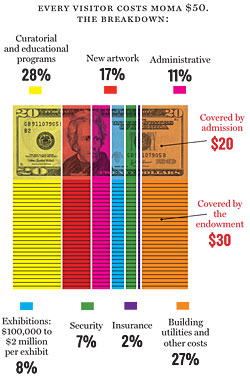
How It Works: MoMA’s annual financial goal is to balance the budget—while collecting worthy art, preserving it, and displaying it to over two million annual visitors. Unlike most museums, MoMA eschews government funding, instead subsisting on a fragmented budget with a half-dozen different sources of income, none larger than a fifth. The strategy is to never rely too heavily on one income channel, and recalibrate annually. “If we know we aren’t going to have the most popular exhibition schedule,” says COO James Gara, “we look at other ways of raising revenue.”
Employees: 815.
Annual Revenue: $145 million (none of which is profit).
Most-Profitable Item: A book: MoMA Highlights ($19.95), a collection of photos of 350 pieces of artwork. MoMA has sold over 100,000 copies in seven languages, generating over $2 million, at a 70 percent profit margin.
Worst Ways to Make Money: Despite the museum’s much-ballyhooed $20 entrance fee, “we lose money on admissions,” Gara says. “It costs about $50 per person who walks in.” The $20 ticket price doesn’t cover security and utilities, and only 50 percent of visitors pay the full price anyway.
Good Business Months: When Edvard Munch is on display, attracting 419,653 visitors.
Bad Business Months: February is its worst month, with 150,000 visitors tops.
Added Value: “We’re more dependent on the New York economy than we’d like to be,” admits Gara. But MoMA’s assets are strong: It plans to grow the $650 million endowment to over $800 million.